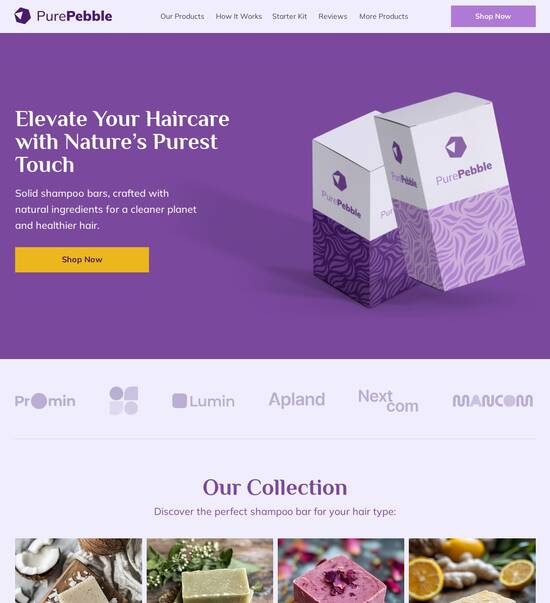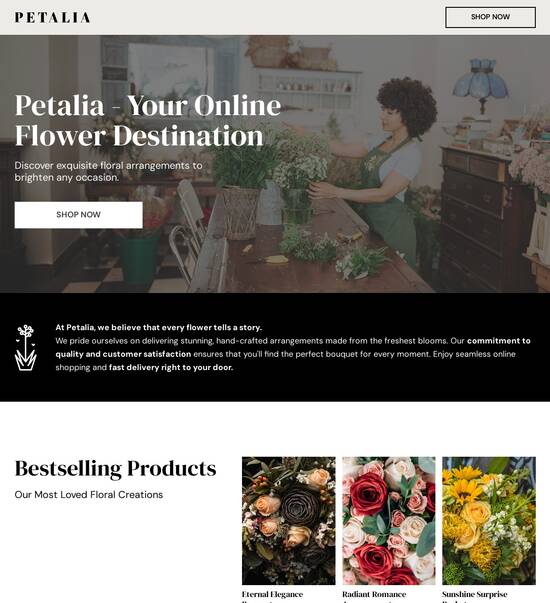
Next.js optimized app download page template
Explore Similar TemplatesAbout template
Supercharge your app download page with Next.js for outstanding performance! Learn more today.
Recommended templates

Easy to build without coding
With the intuitive drag-and-drop builder, anyone on your team can create high-converting pages without any knowledge of code or design. Make enhancements to your landing page with custom widgets using Javascript, HTML/CSS, or third-party scripts.

Multiple layouts for any industry and goal
Select from 500+ landing page layouts built to boost conversions across industry-specific scenarios. Customize them by adjusting fonts, adding images, and generating on-brand content with the AI assistant. Quickly scale with Instablocks® and Global Blocks that you can save, reuse, and update globally.

Loads fast and looks polished on any device
Every template is responsive, which means they present professionally on any device and load blazingly fast with our Thor Render Engine. You can also power them up with Google AMP technology to deliver an unparalleled mobile experience and drive higher conversions.

Robust analytics & experimentation
Get real-time updates and reporting across all your devices, showing the number of visitors, conversions, cost-per-visitor, and cost-per-lead. Launch AI-powered experiments, run A/B tests, and use heatmaps to analyze user behavior, then optimize your landing page to maximize conversions.







Easy to build without coding
With the intuitive drag-and-drop builder, anyone on your team can create high-converting pages without any knowledge of code or design. Make enhancements to your landing page with custom widgets using Javascript, HTML/CSS, or third-party scripts.
Multiple layouts for any industry and goal
Select from 500+ landing page layouts built to boost conversions across industry-specific scenarios. Customize them by adjusting fonts, adding images, and generating on-brand content with the AI assistant. Quickly scale with Instablocks® and Global Blocks that you can save, reuse, and update globally.
Loads fast and looks polished on any device
Every template is responsive, which means they present professionally on any device and load blazingly fast with our Thor Render Engine.
Robust analytics & experimentation
Get real-time updates and reporting across all your devices, showing the number of visitors, conversions, cost-per-visitor, and cost-per-lead. Launch AI-powered experiments, run A/B tests, and use heatmaps to analyze user behavior, then optimize your landing page to maximize conversions.
All the features you need to build next js templates free download
Explore more featuresLearn how to build next js template free download
Frequently asked questions about nextjs onboarding
Leading the way in building high-performing landing pages





Powerful landing page strategies: Leveraging Instapage for effective marketing
When it comes to maximizing the performance of your digital marketing campaigns, Instapage stands as a leading solution. With capabilities focused on creating and optimizing landing pages, marketers can significantly improve return on investment (ROI) and streamline their campaign processes. Instapage offers a suite of tools that cater to both small startups and large enterprises, enabling any marketing department to execute high-impact strategies with ease.
Understanding the essentials of creating high-converting landing pages
A well-structured landing page is crucial for converting visitors into leads. The essence of Instapage lies in its user-friendly features that allow marketers to build stunning pages effortlessly. By leveraging over 100 high-converting templates, you can quickly create an impactful first impression. Each template is designed based on conversion best practices to ensure your marketing efforts yield substantial results.
- High-converting templates: Instapage provides a library of templates tailored for conversion, simplifying the design process.
- Drag-and-drop builder: Easily customize any element without needing technical skills, allowing for faster turnaround times.
- Responsive designs: All landing pages are mobile-optimized to ensure they capture leads on any device.
Streamlining the landing page creation process with Instablocks
Instablocks are reusable segments that allow you to design pages more efficiently. Use elements that have proven to convert and effortlessly integrate them into different pages. Whether you're working on a specific vertical like tech or financial services, Instablocks cater to the nuances of diverse industries, ensuring your pages resonate with your target audience.
- Consistency in branding: Maintain uniformity across various campaigns with reusable blocks, ensuring a cohesive brand image.
- Time-saving: Quickly assemble pages without starting from scratch, significantly accelerating your marketing cycles.
- Customizable elements: Tailor each block to fit your specific campaign objectives and audience preferences.
Optimizing for conversions with built-in tools
Creating a landing page is just the beginning. To truly maximize your results, continuously optimize your pages based on real user data. Instapage offers built-in analytics and A/B testing features to track performance effectively. This iterative approach ensures you’re always improving and adapting your strategy based on what resonates with your audience.
- A/B testing: Experiment with different elements to discover what drives more conversions.
- Heatmaps: Visualize user interactions on your pages to uncover areas for enhancement.
- Performance metrics: Analyze visitor behavior and conversion rates to refine your approach.
In conclusion, equipping your marketing team with the right tools through Instapage can significantly enhance your campaign effectiveness. By leveraging powerful features for landing page creation, optimization, and collaboration, you stand to greatly improve your marketing ROI.
Ready to supercharge your landing page performance? Join the thousands of marketers who have transformed their strategies with Instapage. Start today and watch your conversions soar!
Creating an Optimized App Download Page with Next.js
Understanding Next.js and its role in optimizing app download pages
Next.js is a powerful React framework that streamlines the development process for building web applications. Its primary focus is to provide an excellent user experience while enhancing the performance of websites. With features like static site generation (SSG) and server-side rendering (SSR), Next.js equips developers with the tools needed to create applications that load quickly and efficiently. This capability is crucial for app download pages, where speed directly impacts user retention and conversion rates.
One of the key benefits of using Next.js for application development is its versatility in supporting various rendering methods. Developers can choose between server-side rendering for dynamic content generation at request time or static site generation for faster page loads with pre-rendered content. These features not only enhance performance but also improve SEO, helping your app to rank higher in search results.
Moreover, with its built-in routing system, Next.js simplifies the management of URLs, ensuring that your app download page is optimized for search engines. The ability to integrate external APIs allows developers to enrich the user experience with live data, delivering relevant information without compromising performance. These aspects underscore the significance of choosing Next.js as your framework for building an optimized app download page.
The need for optimized app download pages
Creating effective app download pages poses several challenges in today's competitive landscape. Many users expect quick access to information and seamless interactions, which means that any lag in page loading can lead to lost conversions. The goal is to capture the user's attention quickly and make it easy for them to download the app. By understanding user behavior and analyzing metrics like conversion rates, developers can identify bottlenecks and design more engaging pages.
Optimized app download pages play a crucial role in boosting app downloads. A well-structured landing page, when designed with user intentions in mind, can significantly influence the choice to download an application. Key elements such as clear call-to-action (CTA) buttons, eye-catching visuals, and compelling text are imperative. Additionally, A/B testing different layouts and content variations provides insights into user preferences, enabling continuous improvements.
Ultimately, optimized landing pages not only enhance user experience but can also directly impact app revenue. A focus on conversion-oriented design translates to higher engagement rates, leading to a greater number of downloads. Therefore, understanding the unique requirements and obstacles of creating these pages is essential for developers and marketers alike.
Exploring Next.js optimized app download page templates
Templates within the Next.js ecosystem provide a foundation for developers to quickly launch app download pages without starting from scratch. These templates are specifically designed to leverage Next.js features, offering an excellent jumping-off point for customization and development. By utilizing these optimized templates, developers can significantly reduce the time spent on project setup and focus on enhancing user experience.
Unlike traditional templates that may lack the agility of modern frameworks, Next.js optimized templates integrate various performance and SEO enhancements. This distinction ensures that the websites built using these templates perform better overall. Common use cases for Next.js templates include eCommerce sites, blogs, and, notably, app download pages, where fast load times and clear presentation of information are critical.
Key features of Next.js optimized app download page templates
Next.js templates are packed with key features designed to optimize app download pages, catering to various aspects of web performance and user experience. A notable feature is dynamic routing, which simplifies URL structures, making them more SEO-friendly. This is essential as streamlined URLs can improve visibility and search rankings for your app page.
Another significant feature is static generation and incremental static regeneration, which enhances loading times. By pre-rendering pages, users experience faster access to essential content, improving overall engagement. Furthermore, built-in image optimization allows developers to automatically serve appropriately-sized images, thus improving loading speed and visual appeal.
The integration of RESTful APIs enables seamless connectivity to external data sources, ensuring that content remains fresh and relevant. Predictable user interfaces are further enhanced with support for dark mode and right-to-left (RTL) layouts. These inclusivity features ensure that a diverse user base has a pleasant experience, leading to increased satisfaction.
Crafting the perfect download page: The development process
When creating an app download page using Next.js, the first step is to choose the right template based on your target audience. Consider demographics such as age and tech-savvy levels, as well as performance metrics and features that will appeal to them. Squaring away these factors early on can save you time and energy down the line, avoiding unnecessary adjustments to the design.
The development workflow includes several steps. Begin by installing Next.js, which can be done easily via npm or Yarn. From there, set up routing for your download pages to ensure users can quickly navigate to the app download section of your site. Integrate API calls to populate your page with dynamic content, which can include recent reviews or usage statistics. For styling, consider using CSS Modules or Styled Components to maintain organized and reusable styles.
Finally, don’t overlook the importance of analytics. Implement tracking to understand user behavior on your app download page, providing critical data on what's working and what needs improvement. By following this structured development process, you can create highly effective app download pages that meet user expectations and drive conversions.
Enhancing user experience with best practices
An essential part of crafting a successful app download page is focusing on user experience. High-converting app download pages typically include several vital elements. First and foremost, a clear call-to-action (CTA) is crucial. This should guide users effortlessly toward the download link, ensuring that it stands out on the page. Moreover, incorporating persuasive visuals and user testimonials can enhance credibility, making potential users more likely to take action.
Social proof, such as download counts or user ratings, also significantly strengthens trust. Showcasing these indicators imparts a sense of reliability and encourages visitors to take the plunge. To optimize for performance, developers can adopt A/B testing strategies using Next.js to evaluate which elements resonate more with users. This iterative approach allows for continuous improvement, refining the page over time based on real user data.
The role of SEO in app downloads
SEO plays a fundamental role in driving traffic to your app download page. By utilizing the features of Next.js, developers can significantly enhance their SEO tactics. Structuring content with appropriate meta tags, image alt texts, and keyword optimization helps search engines comprehend the page content better. This increased clarity boosts the potential for higher rankings and, consequently, more organic traffic.
Furthermore, site speed is a substantial factor in SEO rankings and user retention. The faster a site loads, the more likely users will remain on the page and complete a download. Mobile responsiveness, which is particularly vital in today’s landscape where users frequently access sites through their phones, is another critical aspect of optimizing app download pages for better SEO outcomes.
The benefits of using Next.js for developers and users
For developers, Next.js simplifies the overall development process with its intuitive structure and design. Server-side rendering capability enhances the performance of applications, facilitating rapid updates and enhanced SEO. This framework offers developers a robust environment where they can efficiently prototype and iterate on designs, leading to a smoother workflow and reduced time on project completion.
From the end-user perspective, Next.js brings many benefits such as faster loading times which directly translate to better retention rates. Highly responsive interfaces ensure an engaging experience as users interact with download pages. This heightened performance increases usability across different devices, making it easy for users to navigate and complete downloads effortlessly, regardless of whether they are on a desktop or mobile device.
Documentation and community support
Navigating the official Next.js documentation is critical for developers looking to create optimized app download pages. The documentation is structured logically, highlighting essential sections such as routing, API integration, and optimization techniques relevant to download pages. It serves as a primary resource for understanding how to leverage Next.js features to their fullest potential.
Additionally, community-driven resources and tutorials play a significant role in ongoing learning. Engaging with the Next.js community through forums or GitHub can yield valuable insights. Developers can share their experiences, ask questions, and contribute to collaborative learning, which aids in staying updated on best practices and emerging trends in the Next.js ecosystem.
Leveraging community inputs and contributions
Beyond documentation, getting involved in the Next.js community bolsters the learning process. Forums and social media groups provide platforms for developers to share their queries and solutions, enriching collective knowledge. Participation in open-source contributions not only helps refine personal skills but also aids in the development of better templates and resources for the Next.js ecosystem.
Many successful developers share their case studies and success stories, illustrating how they overcame challenges and optimized their projects. These real-world examples can serve as inspiration for those working on app download pages, providing concrete evidence of best practices and innovative solutions that yield tangible returns.
Future trends in app download page optimization with Next.js
The landscape of app download page optimization is continually evolving, influenced by emerging technologies and user expectations. One such trend is the use of artificial intelligence (AI) and machine learning (ML) technologies for user interface customization. By analyzing user behavior and preferences, developers can create tailored experiences that resonate with target audiences, improving engagement and download likelihood.
As Next.js continues to advance, developers can anticipate innovative features that will further simplify the process of creating optimized app download pages. These innovations may include advanced data fetching techniques and deeper integration with third-party services, enhancing performance and interactivity. Staying informed about these trends will enable developers to continually refine their strategies and keep their app download pages aligned with the latest best practices.
Ready to skyrocket conversions?
Supercharge your ad campaigns with high-performing landing pages
Get started














